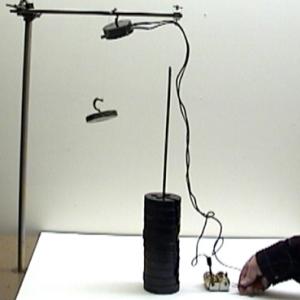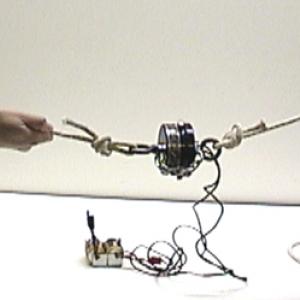College of Liberal Arts & Sciences
5G20.70 - Electromagnet
Hang the electromagnet on a crossbar and energize the magnet. Stick the face plate on the magnet and hang the weights from the hook on the face plate. Disconnect the batteries from the magnet and watch the weights fall.
NOTE: This magnet is rated at about 75 kg at 3 volts when operated properly, however we have several pieces of cellophane tape covering the face plate.
This is because without the cellophane tape the magnetized core still has significant lifting power and the magnet will not come apart easily. With the cellophane tape in place we decrease the amount of weight that the magnet can hold but decrease the magnetic core problem.
The other way to do this is to replace the two hooks on the magnet with the rings and rope assembly. This is so that several young children can pull on each section of the magnet at a time. Should they proceed in pulling the magnet apart the chain will only allow the two halves to come 4" apart.
- Thomas B. Greenslade Jr., "The Three-Pole Electromagnet", TPT, Vol. 49, # 8, Nov. 2011, p. 496.
- Thomas B. Greenslade Jr., "Electro-Magnet with Three Poles", AJP, Vol. 93, #1, Jan. 2025, p. 87.
- r. Ballard, F. Reines, "Reply to Comment by A. A. Marino", AJP, Vol. 42, #3, March 1974, p. 259.
- Andrew A. Marino, "Comment on 'Participatory Lecture Demonstration with an 83-Ton Bar Electrromagnet", AJP, Vol. 42, #3, March 1974, p. 259.
- James E. Stacey, "The Mechanic's Electromagnet", TPT, Vol. 40, # 8, Nov. 2002, p. 505.
- F. Reines, R. Ballard, "Participatory Lecture Demonstration with an 83-Ton Bar Electromagnet", AJP, Vol. 41, #4, April 1973, p. 566.
- Robert J. Reiland, Laboratory Activity 5: "Electromagnets and Magnet Dissection", Teaching About Magnetism, p. 3.21.
- George M. Hopkins, "Dynamic Electricity", Experimental Science, p. 457.
- George M. Hopkins', "Helix", Experimental Science Volume Two, p. 119.
- George M. Hopkins', "Arago Experiment", Experimental Science Volume Two, p. 118.
- Rev. J, Lukin, The Boy Engineers, 1901, p. 322.
- Pat Murphy, Ellen Macaulay, and the Staff of the Exploratorium, "Electromagnet", Exploratopia, p. 322.
- "How to Build Small Electromagnets", The Boy Scientist, p. 208.
- "Discovering Electromagnetism", The Boy Scientist, p. 195.
- Janice VanCleave, "69, Electromagnet", Teaching the Fun of Physics, p. 104.
- Janice VanCleave, "17, Attractive Spirals", Magnets, p. 68.
- Cy Tymoney, "Sneaky Motor II", Sneakiest Uses for Everyday Things, p. 59.
- Cy Tymoney, "Sneaky Motor III", Sneakiest Uses for Everyday Things, p. 61.
- James D. Livingston, "All Ten Facts About the Force", Driving Force- The Natural Magic of Magnets, p. 119.
- Janice VanCleave, "Electromagnet", Physics for Every Kid - 101 Easy Experiments in Motion, Heat, Light, Machines, and Sound, p. 48-49.
- Janice VanCleave, "Line Up", 202 Oozing, Bubbling, Dripping, and Bouncing Experiments, p. 94.
- "Magnetic Field Around a Coil of Wire", Physics From the Junk Drawer, 3rd Edition, The Science House, North Carolina State University, p. 37.
- Grant Mellor, "Winding an Electromagnet", Flying Tinsel, 1993, p. 100-103.
- Bobby Mercer, "Electric Magnet", Junk Drawer Physics, p. 156.
- Sara Stein, "Magnetic Influence", The Science Book, p. 240.
- Rudolf F. Graf, "A Wire Picks Up Iron Filings", Safe and Simple Electrical Experiments, p. 91.
- Rudolf F. Graf, "Making an Electromagnet", Safe and Simple Electrical Experiments, p. 93.
- Herb Strongin, “Building an Electromagnet and Measuring Its Strength“, Science on a Shoestring, p. 171.
- Borislaw Bilash II, “Cling-on Wire“, A Demo A Day – A Year of Physical Science Demonstrations, p. 292.
- Borislaw Bilash II, “Electricity Can be Attractive“, A Demo A Day – A Year of Physical Science Demonstrations, p. 294.
- Joseph Frick, "# 313 - Electro-Magnets", Physical Technics: Or Practical Instructions for Making Experiments in Physics and the Construction of Physical Apparatus with the Most Limmited Means, p. 368.
- Caroline Delbert, "How Do You Build the World's Largest Magnet? It's Complicated", Popular Mechanics, November / December 2021, p. 32.
Disclaimer: These demonstrations are provided only for illustrative use by persons affiliated with The University of Iowa and only under the direction of a trained instructor or physicist. The University of Iowa is not responsible for demonstrations performed by those using their own equipment or who choose to use this reference material for their own purpose. The demonstrations included here are within the public domain and can be found in materials contained in libraries, bookstores, and through electronic sources. Performing all or any portion of any of these demonstrations, with or without revisions not depicted here entails inherent risks. These risks include, without limitation, bodily injury (and possibly death), including risks to health that may be temporary or permanent and that may exacerbate a pre-existing medical condition; and property loss or damage. Anyone performing any part of these demonstrations, even with revisions, knowingly and voluntarily assumes all risks associated with them.

